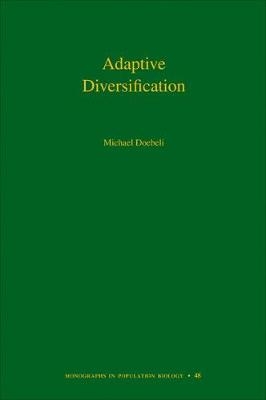
Adaptive Diversification
Princeton University Press (Verlag)
978-0-691-12893-1 (ISBN)
- Titel ist leider vergriffen;
keine Neuauflage - Artikel merken
Understanding the mechanisms driving biological diversity remains a central problem in ecology and evolutionary biology. Traditional explanations assume that differences in selection pressures lead to different adaptations in geographically separated locations. This book takes a different approach and explores adaptive diversification - diversification rooted in ecological interactions and frequency-dependent selection. In any ecosystem, birth and death rates of individuals are affected by interactions with other individuals. What is an advantageous phenotype therefore depends on the phenotype of other individuals, and it may often be best to be ecologically different from the majority phenotype. Such rare-type advantage is a hallmark of frequency-dependent selection and opens the scope for processes of diversification that require ecological contact rather than geographical isolation. Michael Doebeli investigates adaptive diversification using the mathematical framework of adaptive dynamics.
Evolutionary branching is a paradigmatic feature of adaptive dynamics that serves as a basic metaphor for adaptive diversification, and Doebeli explores the scope of evolutionary branching in many different ecological scenarios, including models of coevolution, cooperation, and cultural evolution. He also uses alternative modeling approaches. Stochastic, individual-based models are particularly useful for studying adaptive speciation in sexual populations, and partial differential equation models confirm the pervasiveness of adaptive diversification. Showing that frequency-dependent interactions are an important driver of biological diversity, "Adaptive Diversification" provides a comprehensive theoretical treatment of adaptive diversification.
Michael Doebeli is a professor in the departments of zoology and mathematics at the University of British Columbia.
Acknowledgments xi Chapter 1. Introduction 1 Chapter 2. Evolutionary Branching in a Classical Model for Sympatric Speciation 9 Chapter 3. Adaptive Diversification Due to Resource Competition in Asexual Models 38 3.1 Adaptive dynamics with symmetric competition kernels 50 3.2 Adaptive dynamics with asymmetric competition kernels 64 Chapter 4. Adaptive Diversification Due to Resource Competition in Sexual Models 74 4.1 Evolutionary branching in sexual populations when assortative mating is based on the ecological trait (one-allele models) 82 4.2 Evolution of assortative mating 90 4.3 Evolutionary branching in sexual populations when assortative mating is not based on the ecological trait (two-allele models) 100 4.4 A footnote on adaptive speciation due to sexual selection 110 Chapter 5. Adaptive Diversification Due to Predator-Prey Interactions 113 5.1 Adaptive diversification in classical predator-prey models 114 5.2 An example of evolutionary branching in host-pathogen models 132 Chapter 6. Adaptive Diversification Due to Cooperative Interactions 139 6.1 Diversification in models for intraspecific cooperation 139 6.2 Diversification in coevolutionary models of cooperation 148 Chapter 7. More Examples: Adaptive Diversification in Dispersal Rates, the Evolution of Anisogamy, and the Evolution of Trophic Preference 163 7.1 Diversification in dispersal rates 163 7.2 Diversification in gamete size: evolution of anisogamy 180 7.3 Diversification in trophic preference: evolution of complexity in ecosystems 189 Chapter 8. Cultural Evolution: Adaptive Diversification in Language and Religion 195 8.1 Diversification of languages 197 8.2 Diversification of religions 200 Chapter 9. Adaptive Diversification and Speciation as Pattern Formation in Partial Differential Equation Models 217 9.1 Partial differential equation models for adaptive diversification due to resource competition 218 9.2 Partial differential equation models for predator-prey interactions 236 9.3 Partial differential equation models for adaptive diversification in spatially structured populations 242 9.4 A general theory of diversification in partial differential equation models 258 Chapter 10. Experimental Evolution of Adaptive Diversification in Microbes 262 Appendix: Basic Concepts in Adaptive Dynamics 279 Bibliography 306 Index 323
| Reihe/Serie | Monographs in Population Biology |
|---|---|
| Zusatzinfo | 8 halftones. 52 line illus. |
| Verlagsort | New Jersey |
| Sprache | englisch |
| Maße | 152 x 235 mm |
| Gewicht | 624 g |
| Themenwelt | Mathematik / Informatik ► Mathematik |
| Naturwissenschaften ► Biologie ► Evolution | |
| Naturwissenschaften ► Biologie ► Ökologie / Naturschutz | |
| ISBN-10 | 0-691-12893-6 / 0691128936 |
| ISBN-13 | 978-0-691-12893-1 / 9780691128931 |
| Zustand | Neuware |
| Haben Sie eine Frage zum Produkt? |
aus dem Bereich


